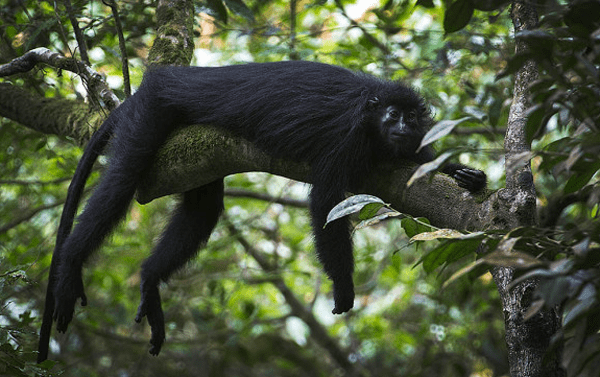Colobus satanas
IUCN
LCBasic Information
Scientific classification
- name:Colobus satanas
- Scientific Name:Colobus satanas,Black Colobus
- Outline:Primates
- Family:Cercopithecidae Colobus
Vital signs
- length:58-72cm
- Weight:6-11kg
- lifetime:About 20 years
Feature
The fur is all black, like a coat extending from the shoulders down to the entire back.
Distribution and Habitat
Distributed in Cameroon, Congo, Equatorial Guinea (Oko) and Gabon.
It inhabits tropical rainforests, mature secondary rainforests, mountain and swamp forests, or woods close to grasslands, occasionally appearing in coastal dunes and forest-steppes.
Appearance
The black colobus monkey is 58-72 cm long, with a tail length of 60-97 cm and a weight of 6-11 kg. It has a light body, slender limbs, and is larger and heavier than ordinary monkeys. The crown hair on the forehead is semi-erect, the anal wart is very small, and the hair color is all black and shiny, extending from the shoulders to the entire back like a coat. The dark, beautiful and flowing tail is longer than the body, sometimes more than 1 meter, without tufts. The cheek pouches are also smaller than those of ordinary monkeys. The forelimbs have four unique fingers, and the thumb has degenerated into a small wart, so it is called a colobus monkey. Although they are both species of the genus Colobus, the black colobus monkey's newborn monkeys are not completely white, but brown.
The tail is long, and the tail end is often hairy, and some are spherical; the stomach is large and complex, divided into several petals to adapt to absorbing nutrients from leaves that are not rich i
Details
Black Colobus (scientific name: Colobus satanas) is called Black Colobus in foreign language. There are 2 subspecies.

Black Colobus monkeys live in the upper and middle layers of the forest and rarely come to the ground. The family consists of an average of 6-15 members, usually including an adult male, several females and their children who have not yet become independent. Several females will raise the young monkeys in the family together. Males will leave home before they become adults, while females will stay in the family. Led by adult males, they defend their territory with loud voices. They are agile and can jump long distances between branches.
Black colobus monkeys can mate and reproduce all year round. The marriage is polygamous. Males are dominant in the family and can mate with any adult female in the group. Female monkeys reproduce every two years. The gestation period is 175 days. Each litter has 1-2 white babies. In the first few months after the baby monkey is born, the female monkeys in the group will help take care of and support the baby monkeys, regardless of whether they are mothers or not. The mother monkeys will take the baby monkeys everywhere to feed them. The baby monkeys always hang on their mothers' chests and hold on to the mothers' fur. Living with their mothers, the baby monkeys grow the same color as their parents after 3 months. They can move freely at 7 months old and are sexually mature at around 4-6 years old. The average lifespan (in the wild) is 20 years.
The distribution range of black colobus monkeys is very limited and their numbers are decreasing. The main threats are habitat destruction, logging and felling of forests for agricultural arable land, as the local native forests are being replaced by cultivated crops. The population is seriously threatened by hunting for its beautiful fur and meat. In Gabon, they live in the Nop region (Gabon), where relatively good protection measures are taken, mainly concessions allocated to loggers to control forest destruction and habitat loss. Elsewhere, they live in the highlands south of Rio Munimont-Alen National Park and Oko. The distribution and status of this species are further protected. Hunting is prohibited.
Listed in the IUCN Red List of Primates ver: 2008 - Vulnerable (VU).
Listed in the CITES Appendix II of the Washington Convention on International Trade in Endangered Species.
Protect wild animals and stop eating game.
Maintaining ecological balance is everyone's responsibility!








